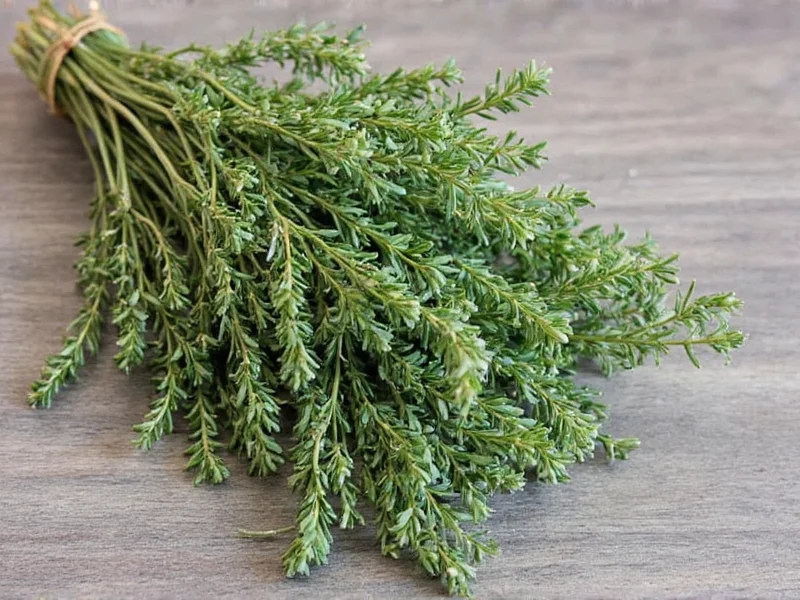Drying fresh thyme properly transforms your garden harvest into a shelf-stable pantry staple that retains its distinctive earthy flavor and aromatic properties for up to a year. Whether you've harvested more thyme than you can use fresh or want to preserve summer's bounty for winter cooking, proper drying techniques make all the difference in maintaining quality.
Why Proper Drying Technique Matters for Thyme
Thyme contains volatile essential oils that give it its characteristic flavor and aroma. These compounds begin degrading at temperatures above 95°F (35°C), making gentle drying methods crucial. Rushing the process with high heat destroys these delicate compounds, resulting in bland, dusty herb rather than the vibrant seasoning you expect. The slow air drying method preserves up to 90% of thyme's essential oils compared to just 60-70% with oven methods.
Optimal Timing for Harvesting Thyme
Harvest thyme in the morning after the dew has evaporated but before the day's heat intensifies. The ideal time is just before flowering when essential oil concentration peaks. Look for stems with vibrant green leaves that feel slightly stiff to the touch. Avoid harvesting after rain or during humid conditions, as excess moisture increases mold risk during drying.
Preparing Thyme for Drying
Carefully inspect each stem, removing any discolored leaves, insects, or debris. Gently rinse thyme under cool running water only if absolutely necessary—excessive moisture prolongs drying time and encourages mold. Pat stems dry with a clean kitchen towel, then allow to air dry for 30 minutes before bundling. Never skip this preparation step when learning how to dry fresh thyme properly.
Comparing Thyme Drying Methods
| Method | Time Required | Flavor Preservation | Best For |
|---|---|---|---|
| Air Drying (hanging) | 1-2 weeks | Excellent (85-90%) | Best overall quality, small batches |
| Dehydrator | 2-4 hours | Good (75-80%) | Humid climates, larger quantities |
| Oven Drying | 2-3 hours | Fair (60-70%) | Urgent drying needs, small amounts |
| Book Pressing | 2-3 weeks | Poor (40-50%) | Decorative purposes only |
Step-by-Step Air Drying Process
Follow these steps for the best method for drying thyme:
- Bundle 4-6 stems together using twine or rubber bands (use loose bands that won't restrict stems as they shrink)
- Hang bundles upside down in a dark, well-ventilated space with temperatures between 60-75°F (15-24°C)
- Maintain humidity below 60% to prevent mold development
- Check bundles every 3-4 days, rotating position for even drying
- Test for dryness after 7 days by rubbing a leaf between fingers—it should crumble immediately
Proper Storage of Dried Thyme
Once completely dry, store thyme properly to maximize shelf life. Remove leaves from stems by running your fingers downward. Store in airtight glass containers away from light, heat, and moisture. The best container for storing dried thyme long term is an amber glass jar with a tight-sealing lid. Properly stored, dried thyme maintains peak flavor for 6-12 months. Check periodically for any signs of moisture or mold.
Dried vs. Fresh Thyme: Culinary Applications
Understand the flavor concentration difference when substituting dried for fresh thyme. Use a 1:3 ratio—1 teaspoon dried thyme equals 1 tablespoon fresh. Dried thyme works best in long-cooking dishes like stews, braises, and soups where it has time to rehydrate and release flavor. Fresh thyme shines in finishing dishes, salad dressings, and quick-cooking applications. Never use dried thyme in applications requiring fresh herb appearance.
Troubleshooting Common Drying Issues
Mold development: Caused by excessive moisture or poor airflow. Start over with drier conditions and smaller bundles.
Faded color: Indicates light exposure during drying. Move to a darker location for future batches.
Weak aroma: Suggests heat damage. Next time use lower temperatures or switch to air drying.
Leaves won't crumble: Thyme isn't fully dry. Continue drying process before storage to prevent mold in containers.











 浙公网安备
33010002000092号
浙公网安备
33010002000092号 浙B2-20120091-4
浙B2-20120091-4